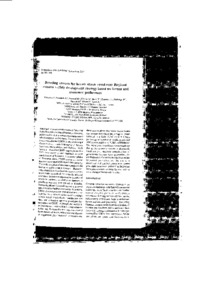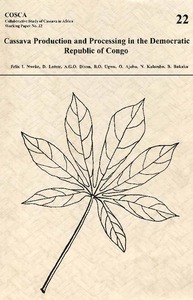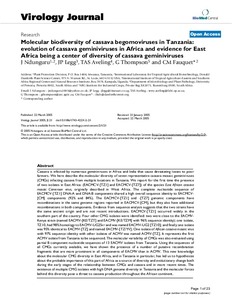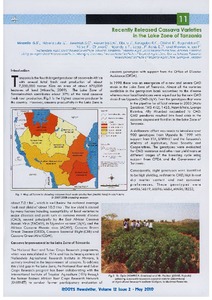| dc.contributor.author | Kanju, E.E. |
| dc.contributor.author | Masumba, E.A. |
| dc.contributor.author | Masawe, M. |
| dc.contributor.author | Tollano, S. |
| dc.contributor.author | Muli, B. |
| dc.contributor.author | Zacharias, A. |
| dc.contributor.author | Mahungu, N.M. |
| dc.contributor.author | Khizzah, B. |
| dc.contributor.author | Whyte, J. |
| dc.contributor.author | Dixon, A. |
| dc.date.accessioned | 2019-12-04T11:14:24Z |
| dc.date.available | 2019-12-04T11:14:24Z |
| dc.date.issued | 2007 |
| dc.identifier.citation | Kanju, E., Masumba, E., Masawe, M., Tollano, S., Muli, B., Zacharias, A., ... & Dixon, A. (2007). Breeding cassava for brown streak resistance: regional cassava variety development strategy based on farmers and consumer preferences. In: 13th Triennial Symposium of the ISTRC in Tanzania: tropical root and tuber crops: opportunities for poverty alleviation and sustainable livelihoods in developing countries, (pp. 95-101), 10-14 November, Arusha, Tanzania. |
| dc.identifier.uri | https://hdl.handle.net/20.500.12478/2753 |
| dc.description.abstract | Cassava is an important food crop in the East African coastal lowlands. However, yields are low due to various reasons amongst which are pests and diseases. Cassava brown streak virus disease (CBSD) is one of the major diseases of economic importance in Kenya, Tanzania, Mozambique and Malawi. Yield losses attributed to CBSD ranging from 49-74% have recently been reported in some coastal areas of Tanzania. It is estimated that in Tanzania alone, CBSD causes economic losses of more than USD 16,000,000 annually. The wide adoption of resistant varieties is the best sustainable control strategy. However, only a hand full of resistant/tolerant varieties is available in each of the severely affected countries. In order to increase the number of resistant varieties available to farmers, a seedling nursery was raised at Kibaha, Tanzania. About 513 seedlings were selected and cloned for further evaluation. At Kibaha, CBSD disease pressure and spread was very high. Therefore, 88% of the harvested seedling were infected. This indicated that this site was ideal for screening cassava genotypes for resistance to CBSD. Although the vector is still unknown, it was very active and infective at this site. Because the seedlings were raised from botanical seeds, ruling out the chance of vegetative plant material transmission, these results prove that vector transmission can account for a large percentage of plants infected in a field. Families with a high percentage of number of seedlings selected {PNSS} included Kiroba, 71762 and 188/00188. The importance of marking diseased seedlings during the growing season is discussed. Furthermore, massive introduction of germplasm through open quarantine, the establishment of crossing blocks to generate improved genotypes and the use of a decentralized participatory evaluation procedure have been initiated as important strategies towards availing farmers with a wider choice of improved varieties. |
| dc.description.sponsorship | Rockefeller Foundation |
| dc.format.extent | 95-101 |
| dc.language.iso | en |
| dc.publisher | International Society of Tropical Root Crops |
| dc.subject | Cassava |
| dc.subject | Manihot Esculenta |
| dc.subject | Plant Diseases |
| dc.subject | Plant Viruses |
| dc.subject | Cassava Brown Streak Disease |
| dc.subject | Cassava Breeding |
| dc.title | Breeding cassava for brown streak resistance: regional cassava variety development strategy based on farmers and consumer preferences |
| dc.type | Conference Paper |
| dc.description.version | Peer Review |
| cg.contributor.affiliation | International Institute of Tropical Agriculture |
| cg.contributor.affiliation | Agricultural Research Institute, Tanzania |
| cg.contributor.affiliation | Kenya Agricultural Research Institute |
| cg.contributor.affiliation | National Institute of Agronomic Research, Mozambique |
| cg.contributor.affiliation | Southern Africa Root Crops Research Network |
| cg.contributor.affiliation | East African Root Crops Research Network |
| cg.contributor.affiliation | East and Southern Africa Regional Center |
| cg.coverage.region | Africa |
| cg.coverage.region | East Africa |
| cg.coverage.region | Southern Africa |
| cg.coverage.country | Kenya |
| cg.coverage.country | Malawi |
| cg.coverage.country | Mozambique |
| cg.coverage.country | Tanzania |
| cg.authorship.types | CGIAR and developing country institute |
| cg.iitasubject | Cassava |
| cg.iitasubject | Disease Control |
| cg.iitasubject | Plant Breeding |
| cg.iitasubject | Plant Diseases |
| cg.howpublished | Formally Published |
| cg.publicationplace | Arusha, Tanzania |
| cg.accessibilitystatus | Limited Access |
| local.dspaceid | 93783 |
| cg.targetaudience | Scientists |




